miniVNA PRO Modifications
Serge Y. Stroobandt, ON4AA
Copyright 2019–2020, licensed under Creative Commons BY-NC-SA
- Home
- miniVNA PRO Modifications
Introduction
The mini Radio Solutions miniVNA PRO is the only affordable vector network analyser (VNA) I know of that offers remote wireless operation. This is very interesting because it allows to measure the input impedance of HF antennas installed at height without having to deal with coax cable lengths, baluns nor common mode suppression chokes.
However, to render the miniVNA PRO truly field proof, it requires a number of significant modifications. After all, nothing is so frustrating as hoisting an antenna in the air only to discover that the Bluetooth connection went down or that the battery drained. Moreover, you want to make sure that this nifty gadget does not fall from height when hoisting it through any tree crowns!
External Li-ion battery pack
The miniVNA PRO comes with an internal 3.7 V, 1000 mAh Li‑ion cell. After some time (used or unused), the capacity of this cell will decay significantly.
The Panasonic B is the most famous out of all 18650 batteries. When first released several years ago it was the highest capacity 18650 cell mass produced and thus an essential ingredient in the rechargeable revolution. It was quickly adopted in electric vehicles like the Tesla Model S, which has been powered by the Panasonic NCR18650B for some years.1
Battery holders for 18650 cells are readily available through Aliexpress. If you decide to use two cells like I did, make sure to order a 18650 holder with the cells connected in parallel and not in series as is usually the case.
The advantage of having an external battery holder is that cells can easily be removed to be charged in a much more reliable and faster Li‑ion battery charger, like for example the Nitecore NEW i4.
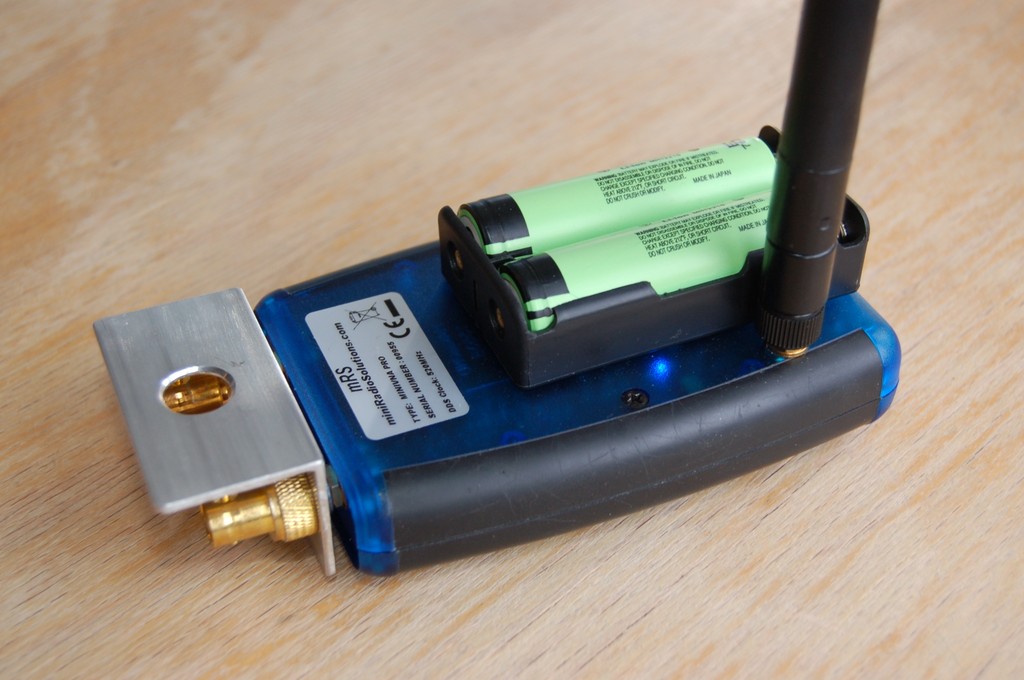
External view of the heavily modified miniVNA PRO showing the external Li-ion battery pack, an external 2.4 GHz Bluetooth antenna and an aluminium hanging bracket held down by two SMA to BNC connector adapters. A steady blue LED is indicative of a stable Bluetooth connection.
External Bluetooth antenna
The idea for improving on the miniVNA PRO’s poor internal Bluetooth antenna came from Teemu Korhonen, SM0W. In contrast to what is shown below, Teemu drilled his hole for the RP‑SMA connector right above the power switch.
Note that it is customary to employ SMA connectors with a reversed polarity (RP) at 2.4 GHz, to differentiate this port from any other ports on the device.
Desolder the miniaturised ceramic antenna. At that same spot, using a drill bit for glass, drill a large hole for the RG‑174/U coax to protrude. Excess PCB trace may be milled away. The center conductor of the RG‑174/U is connected to the second module pin from the lower right. It is easiest to solder the coax braid directly onto the module’s casing.
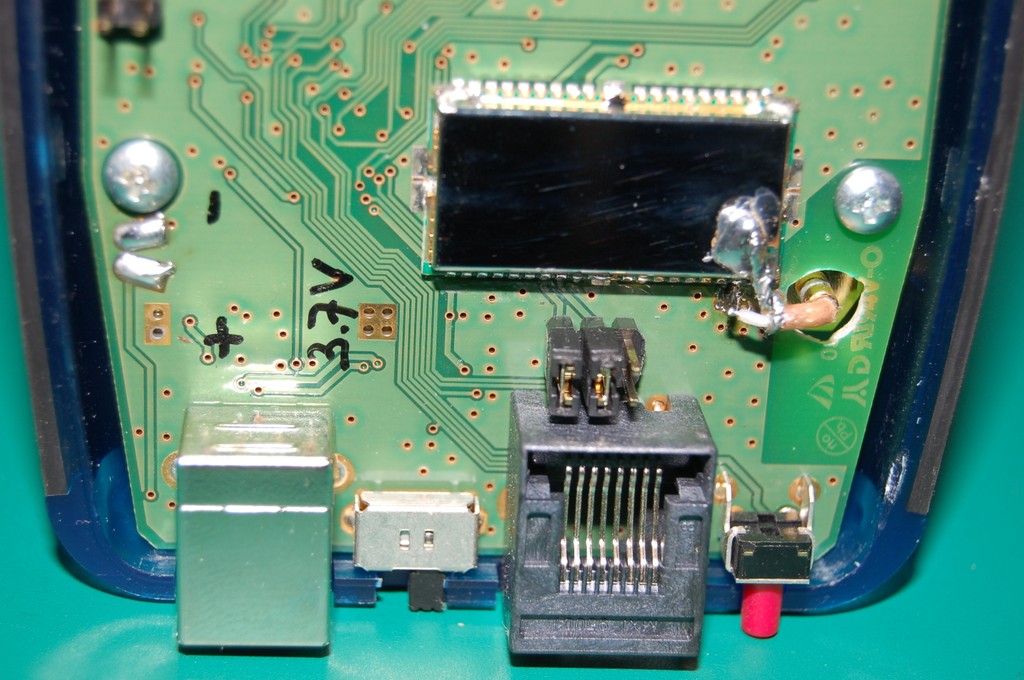
Inside view of the modified miniVNA PRO with the center conductor of the RP‑SMA coax pig tail directly soldered to the second pin from below right of the Bluetooth module. Prior to drilling the hole through the PCB, the ceramic miniature 2.4 GHz antenna on the backside was desoldered. The internal battery connector has also been removed.
Class 1 Bluetooth dongle
Forget about relying on your laptop’s miserable built-in Bluetooth antenna. As hams, we know all what matters is large antennas and high power. The same is true for Bluetooth, especially knowing that Bluetooth shares the same frequency spectrum with the already overcrowded 2.4 GHz WLAN bands.
The Sena Parani-UD100 Class 1 Bluetooth 4.0 dongle is one of the most powerful Bluetooth adapters available on the market. The Class 1 designation means its output power is 100 mW. Moreover, this dongle features an external RP‑SMA connector. Connect it to an aftermarket 2,4 GHz dipole antenna and the open field signal range will extend to up to 600 m!
Good to know: GNU/Linux recognises this Bluetooth adapter right out of the box. There is no need to install any driver. I wrote a separate, detailed article about connecting the miniVNA PRO over Bluetooth using GNU/Linux.
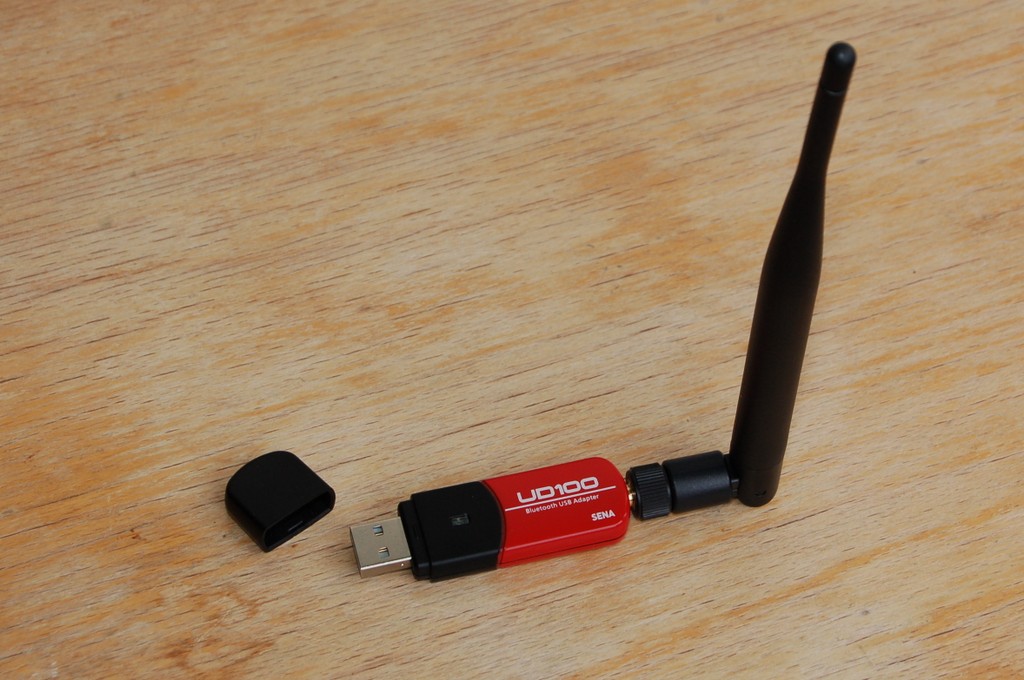
The Sena Parani-UD100 Class 1 (100 mW) Bluetooth 4.0 dongle connected at its RP‑SMA port to an aftermarket 2,4 GHz dipole antenna provides an open field signal at a range of up to 600 m.
Hanging bracket
The miniVNA PRO lacks a hard point to hang it from. Nonetheless, a hanging bracket can easily be made from 3 mm thick aluminium L stock with 30 mm sides. The bracket is held down by the two SMA to BNC connector adapters and stainless steel spring washers at the back (Figure 1). A stainless steel D‑shackle and a 30 cm (1 ft) mountaineering sling are used to secure the VNA to the antenna.
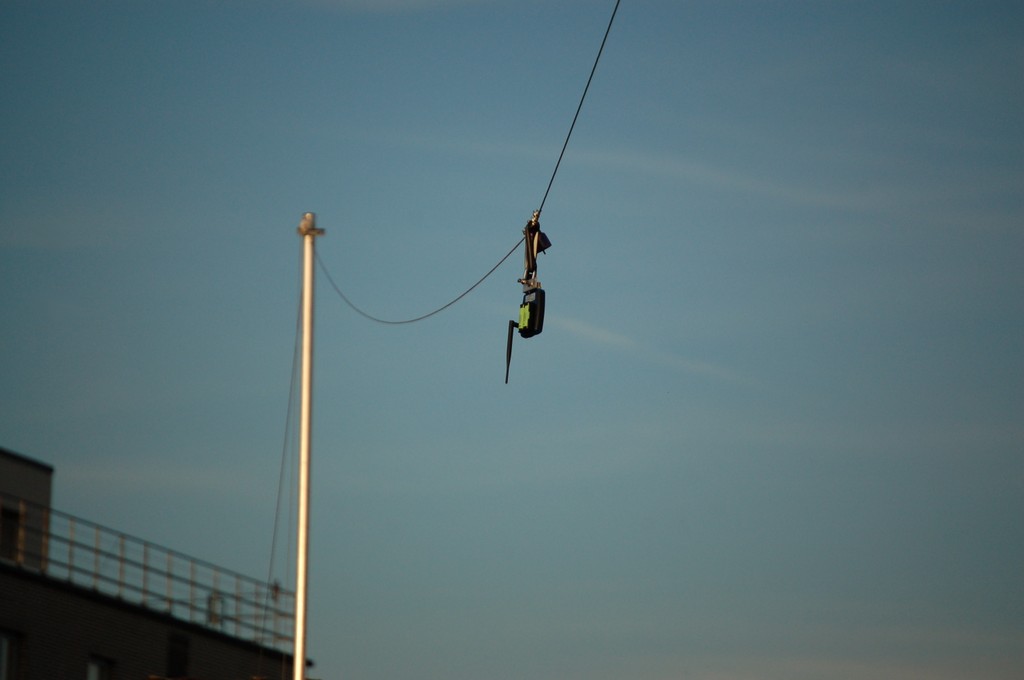
The modified miniVNA PRO hanging from the center of a HF dipole at about 15 m (50 ft) above ground. A balun is not requiered for taking accurate measurements. The VNA can be read from the comfort of my home even though there are quite some 2,4 GHz WLAN signals present in this urban environment. The two 3350 mAh Panasonic NCR18650B Li-ion cells in parallel provide more than enough «juice» for a whole day of measurements.
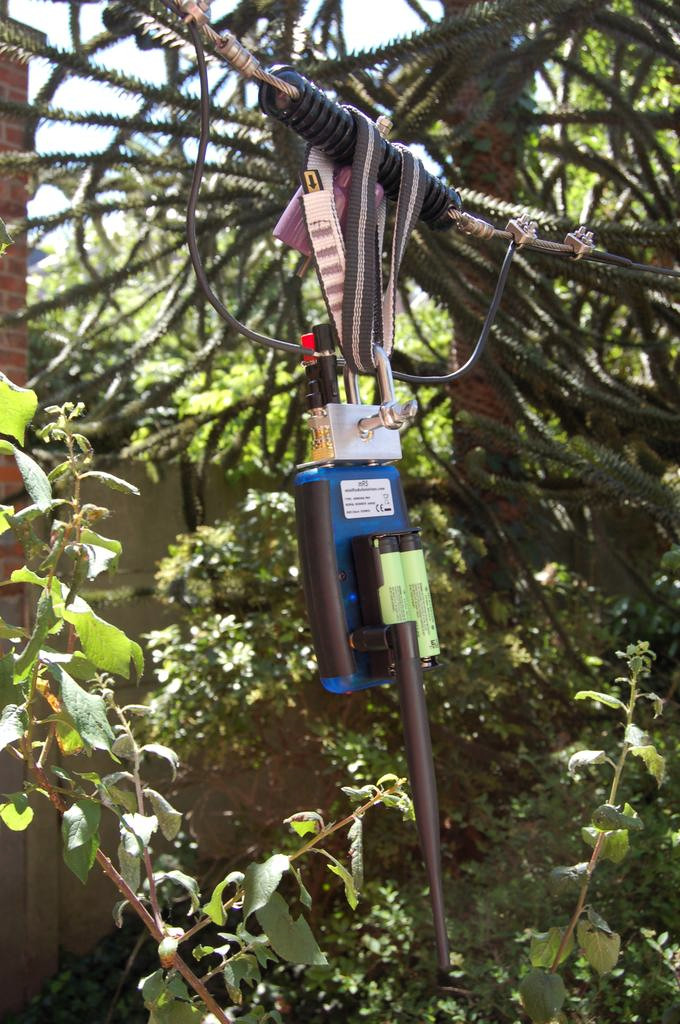
Detail of the modified miniVNA PRO hanging from a lowered wire antenna in my urban jungle. A stainless steel D‑shackle and a 30 cm (1 ft) mountaineering sling are used to secure the VNA to the antenna’s center insulator. Prior to taking any measurements, the VNA was properly calibrated at the banana terminals.
Banana calibration kit
A BNC to banana terminal adapter turns out to be quite handy for measuring components and antennas. Like any VNA measuring lead, such an adapter requires a SOL calibration kit. SOL stands for short, open and load. Calibration allows for cancelling out the effect of the adapter over a wide frequency range. It will put the measuring plane of the VNA right at the level of the banana terminals.
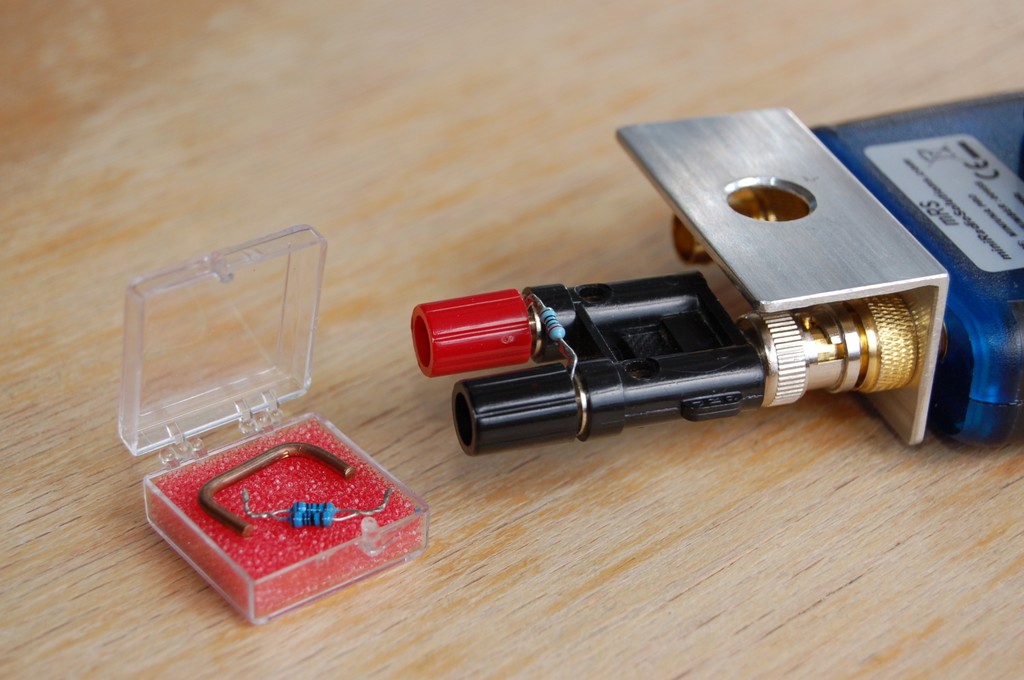
A calibration kit for banana terminals. The tiny plastic box on the left contains a short and a 50 Ω load consisting of two high‑precision 100 Ω low‑inductance metal film resistors in parallel. On the right, a high‑precision 200 Ω low‑inductance metal film resistor for measuring components of CL‑OCFD antennas.
Caveat emptor transmission mode
With professional-grade VNAs, discrete components like inductors or capacitors can be measured more accurately in series-through transmission mode than in reflection mode.2 All VNAs have a vectorial (or complex) \(S_\text{11}\) device under test (DUT) port built around a directional coupler. However, most two-port VNAs sold to the amateur radio community lack a directional coupler behind their second port. This is why ham radio manufacturers call it a scalar \(S_\text{21}\) detector (DET) port.
By consequence, these amateur VNAs are only capable of measuring the scalar gain or attenuation of a two-port device terminated in 50 Ω. A whole slew of extremely accurate transmission mode measuring protocols remain unavailable to hobby VNAs. Do not use any amateur VNA in transmission mode to measure component values. Use reflection mode instead.
Choke measuring jig
As explained above, it is not possible to accurately determine a choking impedance with an amateur VNA in transmission mode. However,
TODO
References

This work is licensed under a Creative Commons Attribution‑NonCommercial‑ShareAlike 4.0 International License.
Other licensing available on request.

Unless otherwise stated, all originally authored software on this site is licensed under the terms of GNU GPL version 3.
This static web site has no backend database.
Hence, no personal data is collected and GDPR compliance is met.
Moreover, this domain does not set any first party cookies.
All Google ads shown on this web site are, irrespective of your location,
restricted in data processing to meet compliance with the CCPA and GDPR.
However, Google AdSense may set third party cookies for traffic analysis and
use JavaScript to obtain a unique set of browser data.
Your browser can be configured to block third party cookies.
Furthermore, installing an ad blocker like EFF's Privacy Badger
will block the JavaScript of ads.
Google's ad policies can be found here.
transcoded by
 .
.


